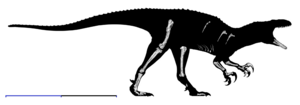Australovenator
| Australovenator | ||||||||||||
|---|---|---|---|---|---|---|---|---|---|---|---|---|

Live reconstruction of Australovenator |
||||||||||||
| Temporal occurrence | ||||||||||||
| Lower Cretaceous (Upper Albium ) | ||||||||||||
| 107.5 to 100.5 million years | ||||||||||||
| Locations | ||||||||||||
| Systematics | ||||||||||||
|
||||||||||||
| Scientific name | ||||||||||||
| Australovenator | ||||||||||||
| Hocknull et al., 2009 | ||||||||||||
| Art | ||||||||||||
|

Australovenator was a medium-sized genus of carnivorous dinosaurs belonging to the Allosauroidea group thatlivedin Australia during the Late Cretaceous (Late Albian ). It is the largest predator found in Australia to date. The only species of this genus is Australovenator wintonensis .
description
Australovenator was 6 meters long. Thanks to a waist height of 2 meters, he reached a maximum height of 2.50 meters. The head measured sixty centimeters, the weight was over half a ton.
Find history
The fossils come from the Winton Formation near Winton . Here individual skeletal elements of Australovenator were found in a clayey layer between layers of sandstone , including teeth, part of the lower jaw, parts of the front and rear limbs, part of the iliac bone , ribs and abdominal ribs . Until then, only small pieces of bones had been found by theropods in Australia. In 2009 Australovenator was reconstructed and described by a team of Australian scientists.
The layer in which Australovenator was found was apparently the remains of an oxbow lake in the floodplain of a river. In addition to the fossil remains of the lungfish Metaceratodus ellioti and the crocodile-like Isisfordia duncani , turtles, mussels and snails have been found. Another dinosaur find from this site could also be described for the first time in the work of the Australian scientists. It was a plant-eating sauropod , the Diamantinasaurus matildae was called. Diamantinasaurus , named after the Diamantina River that runs near the site , may have been prey for the carnivorous Australovenator .
After the first description of Australovenator , it is discussed whether the ankle bone found in the early 1980s in the Australian state of Victoria , which was assigned to an Allosaurus , also belongs to a specimen of Australovenator or a close relative.
Systematics
Australovenator has characteristics of the Allosauroidea and seems to be closely related to the Fukuiraptor found in Japan and the Neovenator from the Isle of Wight . However, these two theropods are older than Australovenator and come from the early Lower Cretaceous . Australovenator stands at the transition between Lower Cretaceous and Upper Cretaceous (from Albium to Cenomanium ) and can be understood as an intermediate form at the base of the Carcharodontosauridae , which include Carcharodontosaurus from Africa and Giganotosaurus from South America. The discovery in Australia speaks for the paleobiogeographically wide distribution of this group of forms on the supercontinent Gondwana . He can give further information about the phylogeography of the Cretaceous Period.
Naming
Australovenator wintonensis can be translated as "Winton's southern hunter". The composition Australovenator indicates on the one hand the place of discovery in the southern hemisphere ( lat. Austral , australis - "south"), on the other hand to the predatory way of life (lat. Venator - "hunter") of the carnivore. The specific epithet wintonensis points to the city of Winton , on whose territory the site is located. This theropod was called "Banjo" by scientists before it was first described, in honor of the writer Andrew Barton Paterson , who wrote his works under the pseudonym The Banjo and was usually called Banjo Paterson. Under this name he is also known as the author of the text of the unofficial Australian national anthem Waltzing Matilda , which he wrote during a stay in Winton. Based on this incident, another dinosaur find from the Winton Formation near Winton, a herbivorous titanosaur , called Diamantinasaurus matildae .
literature
- Scott A. Hocknull, Matt A. White, Travis R. Tischler, Alex G. Cook, Naomi D. Calleja, Trish Sloane, David A. Elliott: New mid-Cretaceous (latest Albian) dinosaurs from Winton, Queensland, Australia. In: PLoS ONE . Vol. 4, No. 7, 2009, e6190, doi : 10.1371 / journal.pone.0006190 .
- Roger BJ Benson, Matthew T. Carrano, Stephen L. Brusatte: A new clade of archaic large-bodied predatory dinosaurs (Theropoda: Allosauroidea) that survived to the latest Mesozoic. In: Natural Sciences . Vol. 97, No. 1, 2010, pp. 71-78, doi : 10.1007 / s00114-009-0614-x .
Individual evidence
- ^ Gregory S. Paul : The Princeton Field Guide To Dinosaurs. Princeton University Press, Princeton NJ et al. 2010, ISBN 978-0-691-13720-9 , pp. 98-99, online ( memento of the original of July 13, 2015 in the Internet Archive ) Info: The archive link was inserted automatically and not yet checked. Please check the original and archive link according to the instructions and then remove this notice. .
- ↑ a b Scott A. Hocknull, Matt A. White, Travis R. Tischler, Alex G. Cook, Naomi D. Calleja, Trish Sloane, David A. Elliott: New mid-Cretaceous (latest Albian) dinosaurs from Winton, Queensland, Australia. In: PLoS ONE. Vol. 4, No. 7, 2009, e6190, doi : 10.1371 / journal.pone.0006190 .
- ↑ Ralph E. Molnar, Timothy F. Flannery, Thomas HV Rich : An allosaurid theropod dinosaur from the Early Cretaceous of Victoria, Australia. In: Alcheringa. Vol. 5, No. 2, 1981, ISSN 0311-5518 , pp. 141-146, doi : 10.1080 / 03115518108565427 .
- ↑ Giant dinosaur discovered: Australovenator wintonensis . In; Basler Zeitung , July 3, 2009 (accessed July 2, 2014).
Web links
- Australovenator wintonensis "Banjo" Australian Age of Dinosaurs

